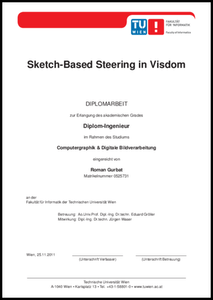Information
- Publication Type: Master Thesis
- Workgroup(s)/Project(s):
- Date: November 2011
- TU Wien Library:
- First Supervisor:
Abstract
Natural phenomena like earthquakes or floods cannot be avoided or controlled by humans but ignoring them can be fatal. In order to understand their characteristics and behavior computer simulations can be used. The gained knowledge is used to find strategies and countermeasures to minimize the damage caused by such disasters. Visdom is a modular integrated visualization system which is developed to support the analysis of flood simulations. It provides the ability to test different decisions made by the user for example the establishment of barrier arrangements. These alternative scenarios can be visualized and analyzed in order to find the solution which minimizes damage in the vicinity. For modifying the flood, the simulation parameters have to be varied. In Visdom, this has to be done by inserting numeric values into textfields or using sliders. In most cases, the system is intended to be used in time-critical situations where fast interaction and testing is required. Therefore a sketch-based interface is introduced into Visdom which should simplify and accelerate the modification of simulation parameters. This kind of interaction increases the productivity and efficiency of the whole work-flow due to its intuitive and straightforward usage. Since Visdom is based on a modular data-flow system, the new functionality is implemented within a new node. The so-called Spline Node provides methods to create and manipulate a spline. It requires the drawn user input points which are captured by a view node. Due to the fact that Visdom is based on the data-flow concept, a new mechanism called Modular Interactors has to be introduced to enable interaction communication between nodes especially upstream. In order to support the user during the sketching process the system provides visual feedback. The sketched stroke is represented using a tubular geometry which is directly visualized in the 3D view.Additional Files and Images
Weblinks
No further information available.BibTeX
@mastersthesis{Gurbat_2011_SBS,
title = "Sketch-Based Steering in Visdom",
author = "Roman Gurbat",
year = "2011",
abstract = "Natural phenomena like earthquakes or floods cannot be
avoided or controlled by humans but ignoring them can be
fatal. In order to understand their characteristics and
behavior computer simulations can be used. The gained
knowledge is used to find strategies and countermeasures to
minimize the damage caused by such disasters. Visdom is a
modular integrated visualization system which is developed
to support the analysis of flood simulations. It provides
the ability to test different decisions made by the user for
example the establishment of barrier arrangements. These
alternative scenarios can be visualized and analyzed in
order to find the solution which minimizes damage in the
vicinity. For modifying the flood, the simulation parameters
have to be varied. In Visdom, this has to be done by
inserting numeric values into textfields or using sliders.
In most cases, the system is intended to be used in
time-critical situations where fast interaction and testing
is required. Therefore a sketch-based interface is
introduced into Visdom which should simplify and accelerate
the modification of simulation parameters. This kind of
interaction increases the productivity and efficiency of the
whole work-flow due to its intuitive and straightforward
usage. Since Visdom is based on a modular data-flow system,
the new functionality is implemented within a new node. The
so-called Spline Node provides methods to create and
manipulate a spline. It requires the drawn user input points
which are captured by a view node. Due to the fact that
Visdom is based on the data-flow concept, a new mechanism
called Modular Interactors has to be introduced to enable
interaction communication between nodes especially upstream.
In order to support the user during the sketching process
the system provides visual feedback. The sketched stroke is
represented using a tubular geometry which is directly
visualized in the 3D view.",
month = nov,
address = "Favoritenstrasse 9-11/E193-02, A-1040 Vienna, Austria",
school = "Institute of Computer Graphics and Algorithms, Vienna
University of Technology ",
URL = "https://www.cg.tuwien.ac.at/research/publications/2011/Gurbat_2011_SBS/",
}

 Thesis
Thesis
